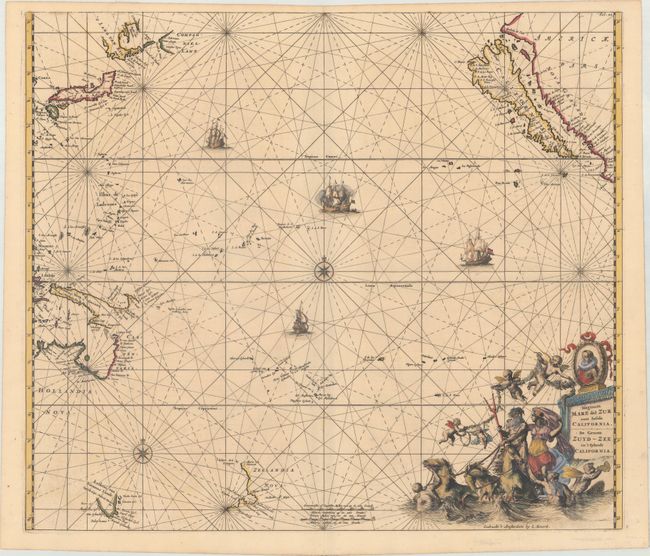Subject: Pacific Ocean, California
Period: 1715 (circa)
Publication: Atlas de la Navigation et du Commerce
Color: Hand Color
Size:
22.3 x 19.4 inches
56.6 x 49.3 cm
This is the second state of De Wit's superb mariner's chart of the Pacific Ocean showing the island of California, published by Renard. California is depicted with an indented northern coast on the second Sanson model, copied from Pieter Goos' Paskaerte van Nova Granada, en t'Eylandt California from 1666. The important Dutch discoveries are noted on the northern coast of Australia: Carpentaria, New Guinea, Anthoni van Diemens Landt (Tasmania), and New Zealand. North of Japan the discoveries of De Vries are shown along with disembodied sections of 't Land van Eso and Compagnies Lant. De Wit has omitted the chain of islands and hypothetical coastline of the southern continent that is commonly found on maps of this period. Instead he has presented a fairly good view of the few known Pacific Island groups. The chart is adorned with rhumb lines, sailing ships, sea battles, and a compass rose. The allegorical title cartouche features a portrait of Magellan, cherubs, and Neptune with a female consort riding a brace of sea-horses. This chart covers an area from the equator to 50°N.Lat. and south to 45°S. Lat.
First published circa 1675, de Wit's sea atlas, Orbis Maritimus ofte Zee Atlas, contained 27 charts from the North Pole to North and South America. The charts all appear to have been engraved by Romain de Hooghe and are splendid examples of Dutch marine works. The atlas was reprinted with amendments by Louis Renard in 1715, by Reinier and Josua Ottens in 1739 and 1745, and finally by the widow of van Keulen in 1802.
References: McLaughlin #59-2; Shirley (BL Atlases) M.REN-1a; Tooley (Australia) #1372; Tooley (Amer) p. 122, #40.
Condition: A
A crisp impression with original outline color in the map and later color in the decorative elements. There are remnants of hinge tape on verso.


